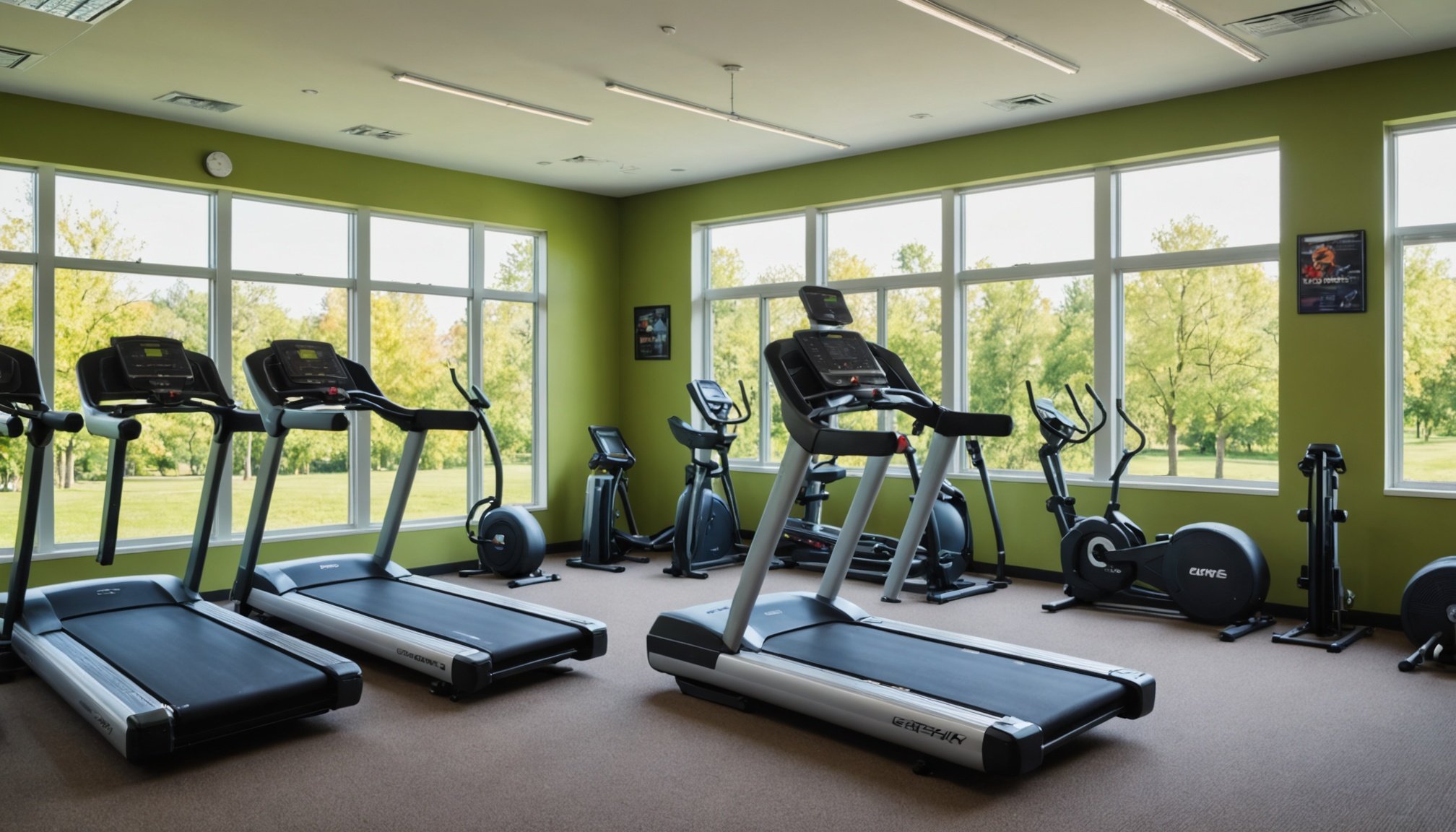Overview of Eco-Friendly Gyms
In recent years, the concept of eco-friendly gyms has garnered significant attention. But what exactly are eco-friendly gyms, and why are they important? Eco-friendly gyms are fitness centers designed with sustainability in mind, incorporating practices that minimise environmental impact while promoting healthier lifestyles. These gyms aim to reduce energy consumption and waste, using sustainable materials and innovative solutions.
One of the driving forces behind the increasing popularity of sustainable fitness is the growing awareness of environmental issues. More individuals are seeking ways to align their fitness habits with their values, opting for gyms that reflect a commitment to the planet. As this trend continues, the demand for green gym practices, such as reducing carbon footprints and using eco-friendly materials, is on the rise.
Also to see : Discover the Best Smart Lighting Solutions for Your Home Automation System
An exciting development in these gyms is the integration of energy-generating equipment. These innovative machines, such as treadmills and stationary bikes, convert the user’s kinetic energy into electricity. This not only helps power the gym but also educates gym-goers about energy conservation. This engaging technology encourages individuals to contribute directly to their gym’s sustainability efforts, marrying fitness and environmental responsibility in a harmonious blend.
Benefits of Energy-Generating Workout Equipment
The rise of energy-generating equipment in the fitness world marks a revolutionary shift towards sustainability. Not only does this technology contribute to the reduction of energy costs, but it also effectively lowers the carbon footprint of gyms and fitness enthusiasts. By capturing and converting kinetic energy into electricity, these machines offer eco-friendly fitness advantages that appeal increasingly to environmentally-conscious consumers.
Also to read : Designing a Chic Multi-Tiered Indoor Plant Stand Perfect for Minimalist Interiors
One of the most exciting benefits is the way energy-generating equipment can enhance user motivation. Imagine the tangible satisfaction of seeing your workout directly contribute to energy savings. This immediate feedback loop heightens user engagement, transforming a routine sweat session into an empowering experience with measurable benefits.
For gyms, the integration of such technology can significantly impact brand image. Facilities that incorporate sustainable solutions send a compelling message: they are committed to ecological responsibility. This not only attracts clients who prioritize sustainability but also sets them apart in a competitive market. Being a pioneer in eco-friendly practices can lead to increased membership and a dedicated client base.
The shift towards sustainable workout benefits is not just a trend; it is a meaningful step towards a more sustainable lifestyle, influencing both personal health and global environmental impact.
Types of Innovative Energy-Generating Equipment
Innovative gym equipment has transformed workout spaces by integrating technology that allows for energy generation while exercising. This makes fitness not only beneficial for health but also for sustainability.
Energy-Generating Cardio Equipment
Cardio machines, such as treadmills and stationary bikes, now come with features that allow them to capture energy from workouts. These energy-generating machines convert human kinetic energy into electricity, which can be used to power the gym or even fed back into the power grid. Top brands offer models with built-in generators that harness energy efficiently.
Strength Machines with Energy Capture
Strength machines have evolved with technology that supports energy capture from the mechanics of exercise movements. These machines are equipped with special mechanisms that store and convert the energy exerted during resistance training into usable electrical power. Not only does this reduce overall energy consumption, but it also encourages an environmentally friendly workout experience.
Accessories and Wearables Providing Energy Output
Fitness technology extends to accessories and wearables that harness energy. Items like smart shoes and power-generating workout mats help collect energy produced through movement, powering small devices or providing feedback data to enhance your fitness regime. These innovative gym equipment pieces are perfect for tech-savvy fitness enthusiasts looking to reduce their carbon footprint while keeping active.
Case Studies of Eco-Friendly Gyms
Exploring successful eco-friendly gyms provides actionable insights into sustainable practices. These case studies showcase the transforming power of gym sustainability examples in creating environmentally conscious fitness spaces.
A notable example is Green Gyms, which has integrated energy-generating equipment such as treadmills and bikes that convert user workouts into electricity. This not only reduces reliance on non-renewable energy sources but also encourages members to participate actively in sustainability efforts as they see tangible outcomes from their sessions.
Another fascinating approach can be found at the Eco Fitness Centre. Through solar panels and maximization of natural light, they significantly cut down on energy consumption. Moreover, they leverage waterless urinals and low-flow fixtures, reducing water usage dramatically. This demonstrates the commitment to environmental stewardship and sets a benchmark in sustainable design.
The real impact of these initiatives is evident in community and member responses. Members express a sense of pride and satisfaction in contributing to a greener planet, which enhances the overall gym experience. This has led to increased membership retention and a broader community engagement, highlighting the positive societal impact of embracing sustainability.
In analyzing these case studies, it becomes apparent that eco-friendly strategies not only benefit the environment but also elevate the member experience, creating a win-win situation.
Guidelines for Implementing Eco-Friendly Practices
Transitioning to sustainable gym practices involves strategic planning and execution. Gym owners can start by embracing a step-by-step approach to ensure a comprehensive adoption of eco-friendly solutions. Begin by evaluating the current energy consumption and identifying areas for improvement.
Firstly, consider integrating energy-generating equipment into the existing gym layout. These machines can convert the kinetic energy from workouts into usable electricity, helping reduce reliance on external energy sources. Incorporate treadmills, bikes, and ellipticals designed for energy production to maximize impact.
Secondly, an implementation guide is crucial for a seamless transition. Outline clear stages for adopting new technologies, assigning specific tasks and deadlines for each phase. This guide will serve as a roadmap, ensuring all stakeholders are aligned and objectives are met efficiently.
Educating gym staff and members on maintaining and using these eco-friendly technologies is vital. Offer training sessions to demonstrate the proper handling and benefits of sustainable equipment. Facilitate workshops to communicate the long-term advantages of eco-friendly fitness solutions.
Finally, regularly conduct maintenance checks to ensure equipment efficiency. Create a schedule for routine inspections and engage staff in learning basic troubleshooting techniques. By following these guidelines, gym owners will not only reduce their carbon footprint but also inspire a community-wide shift towards sustainability.
Visuals and Infographics
Incorporating visual representation and data visualization can significantly enhance the understanding and engagement of eco-friendly fitness concepts. By using infographics, complex information on energy generation and savings becomes easier to digest. These tools transform raw data into appealing visuals, making the information more accessible to a broader audience.
Eco-friendly fitness infographics should be designed with clarity and simplicity in mind. The goal is to deliver insights, not overwhelm viewers with excessive details. It’s recommended to use contrasting colours and clear fonts to guide the viewer’s eye through the story the data tells. Designing with the audience in mind ensures that each infographic serves its purpose without neglecting the aesthetic.
When creating infographics about energy generation, useful data points could include the amount of energy each type of exercise generates or potential savings from eco-friendly machines compared to traditional gym equipment. These visuals not only convey the immediate benefits but also inspire more sustainable practices among fitness enthusiasts.
Adding visuals and infographics into eco-friendly fitness environments can attract and educate users effortlessly, aligning their well-being goals with environmental consciousness. These tools are invaluable in fostering engagement, enhancing strategy effectiveness, and ultimately promoting a more sustainable lifestyle.
Future Trends in Sustainable Fitness
The future of fitness is set to undergo remarkable changes with the integration of eco-innovation in sports. A standout prediction is the development of energy-generating equipment. Imagine treadmills and bikes that feed power back into the gym’s electrical grid. While such innovations could significantly reduce energy consumption, they may also face hurdles such as high initial costs and maintenance requirements.
Not to be overlooked is the growing importance of sustainability in gym marketing. As environmental concerns rise, gyms and fitness centers are increasingly promoting eco-friendly values to retain consumer attention. Members are drawn to facilities that align with their views on sustainability, often choosing gyms that incorporate recycled materials and energy-efficient lighting.
Yet, advancing these trends involves navigating potential challenges. The path to eco-innovation requires careful consideration of material selection, technology adaptations, and member education. As fitness equipment evolves, consumers may need guidance on using new, sustainable technologies effectively.
By focusing on these emerging trends, the fitness industry can not only contribute positively towards environmental goals but also set an inspiring example of innovation meeting sustainability. Adopting these changes promises not only to revolutionize gym facilities but also reshape how we approach personal health and environmental stewardship.











